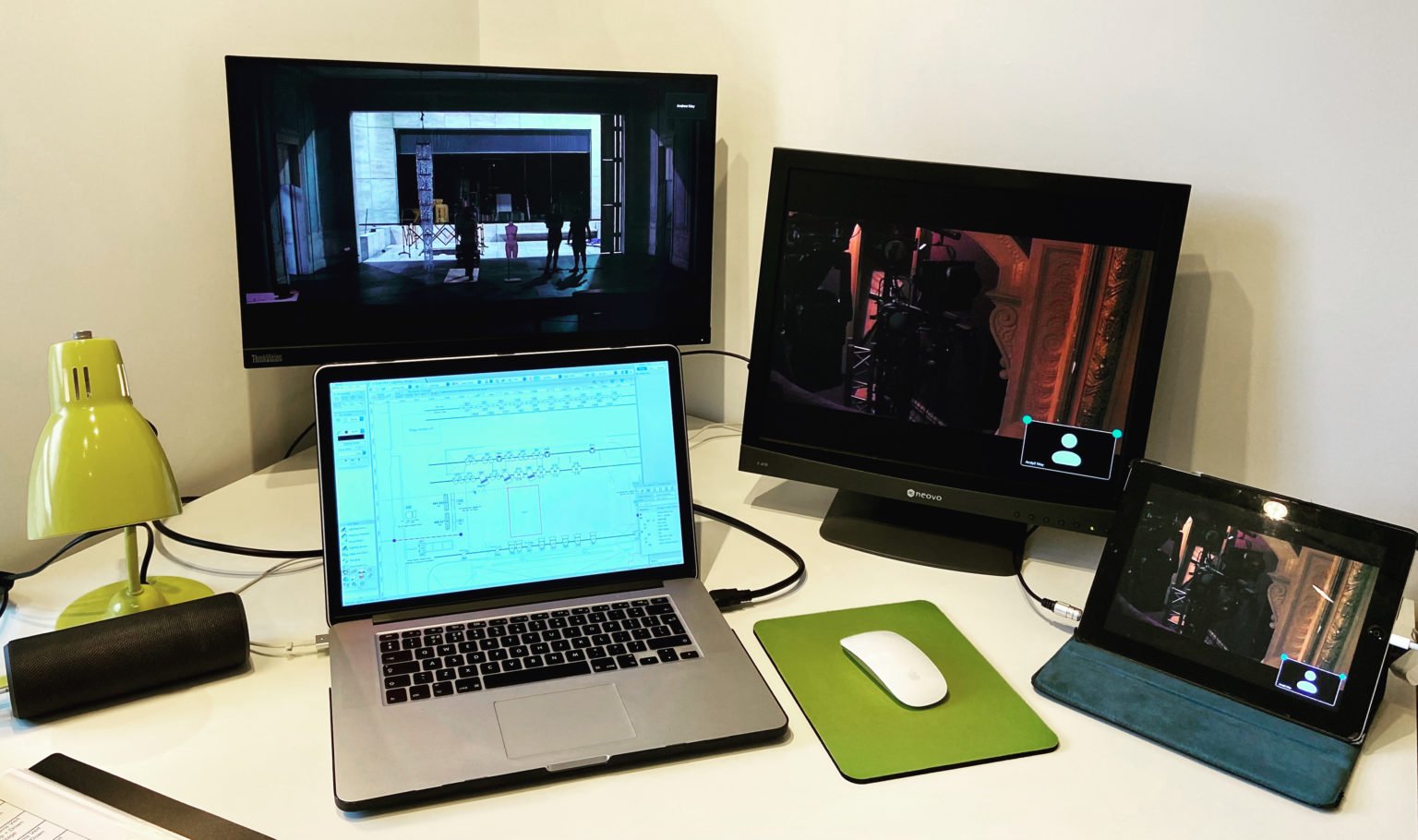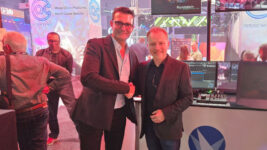News
20 Apr 2021
WA Opera’s Così fan tutte: Remote Production is Not The New Normal

Subscribe to CX E-News
Nicholas Hytner’s 2006 Glyndebourne production of Mozart’s Così fan tutte was happily packed in four shipping containers and on its way to Perth when the pandemic outran it. Scheduled by West Australian Opera to run at His Majesty’s Theatre 24-31 October 2020, the company had already booked UK-based director Bruno Ravella and LD Andrew May to fly over for rehearsals and production. So what to do? Let’s start with a Zoom meeting…
WA Opera’s Production Manager Mandy Farmer wasn’t going to let a global health emergency stop the show. “It was our idea to do this remotely,” relates Mandy. “We thought it just wasn’t fair to either Bruno Ravella or Andrew May to cancel their contracts, especially in view of how dire the situation had become for live productions in the UK, where they were stuck. The team at Glyndebourne said they’d had some success with Zoom as a tool, and we’d already trialled it with Bruno for some pre-production. We thought it could work for direction, production and tech when we got into the theatre, so we consulted with Paule Constable, the original lighting designer who is based in the UK and was keen for WA Opera to work with Andrew. Both Paule and Andrew agreed to his working remotely via Zoom. Decision made, it was then up to the Perth Theatre Trust’s Mick Rippon, Head of Lighting, and Jeremy Turner, Head of Sound & AV, to make it work technically.”

Mick Rippon 
Jeremy Turner 
Mandy Farmer 
Andrew May
“Our initial plan was to have a camera capturing a wide shot of the stage, and the ability for the director to talk to the performers,” states Jeremy Turner. “These requirements expanded as we realised Andrew needed more to do his job. We decided on two separate Zoom sessions, running simultaneously, which Andrew viewed via two separate monitors at home. The first session was for both Bruno and Andrew; we took the wide stage view into Zoom via a Blackmagic Design Web Presenter. The sound console was set-up to take audio from stage, and the stage manager’s talk mic, and send it to Bruno. We then output audio from Bruno to the foldback for the singers.”
“The second Zoom session was more complicated,” continues Jeremy. “We patched Zoom into our Riedel comms system so Andrew could talk to LX over comms like he was in the theatre. We set-up a second roaming camera, which we moved to wherever it was Andrew needed to see. We took a video split out of the ETC Gio lighting console of its programmer view, and the local board op had a vision switcher to switch between different console views. Via an audio interface, Andrew could switch comms channels from LX to SM. It all worked incredibly well.”

Running in-house performance relay cameras repurposed as HD 1080p VC feeds, there was a lot of tweaking and adjustment to ensure Andrew was getting the most accurate colour and brightness reproduction at the far end.
“I hadn’t worked as an LD remotely before, and I don’t know anyone who has,” admits Andrew May. “In terms of workflow, setting levels and colour balancing was the hardest thing about it. We had two cameras, and my two monitors giving different images and looks. We also tried a couple of mobile phones as well. Between the phones and the cameras, we could work out a fair balance between cyclorama, back light, and front light. It was really about trust with Mick and the LX team at the theatre. I was explaining the concept of any given lighting state a lot more than I would normally; what kind of feel I was going for and what is happening, lighting-wise.”
“Sometimes, it was like Andrew was really in the theatre,” recalls Mick Rippon. “When we first started talking to Andrew, we weren’t exactly sure what he was seeing. Then he’d ask, for example, about balance. Then we’d tentatively question, what’s the intent here? Is that too much shadow on one side of the face, or is that the intent of the design and how we’re playing with simulated sunlight angles at the time of day? Once we got used to the process, the conversations became more fluid. The first few times we were learning how to ask questions we wouldn’t normally ask an LD.”
“Those kinds of conversations between the LD and the crew never happen under normal circumstances,” Andrew notes. “It’s ‘what I see, and what I would like’, and it could be bright pink, but the thetare technicians would never question the designer. We learnt quickly that we could be honest, and I’d be open about what the design needed to be and how it should look.”
Accommodating the eight-hour time difference between Perth and the UK, WA Opera shifted tech hours from 9 am to 6 pm, to 2 pm to 10 pm. Already used to a shifted schedule after four weeks in rehearsals with Bruno Ravella on Zoom, the tech team were very accommodating, and stayed on if Andrew needed to stay an extra hour.
“The Così set is beautiful, but there are a couple of tricky elements to it in terms of positioning cross lights and overhead bars,” illustrates Andrew. “One of the bars the set is built around needs to be positioned perfectly as it is being built. This was one of the things that was hard about not being there.” Mick agrees; “If Andrew had been in the room, there would have been quick pick-ups of issues, but as it was there were some small delays due to his remoteness.”
While everyone is happy about being able to work on the production under less-than-ideal circumstances, no-one involved wishes remote production to become the norm. “We could do it again if we had to, but I’d push back as much as possible,” confirms Mandy. “We wanted Così to work and for people to get paid, but it meant Andrew worked harder, longer hours. The argument now is to not make this the norm. Some would love it from a financial perspective, but the beauty of theatre is in people getting together to make it.”
“I’m pleased we were able to successfully put on the production remotely, but it is not the future,” concurs Andrew. “I really enjoyed the experience of working with WA Opera, which made it even harder not to be there in person. They are a fantastic team to work with. And the first night, hearing the audience after not having an audience for seven months, was very emotional for me. Bruno and I watched opening night remotely, from our homes in different parts of the UK, chatting on WhatsApp, with a glass of champagne. I even put my jacket on.”
The emotion was shared back at His Majesty’s. “It was strange, as we don’t know Andrew and haven’t even been in the same room as him,” observes Mick. “As we all just had to make it all work, coming out of COVID, it was quite emotional. It was quite poignant when the production finished, as we all had such an emotional investment.
WA Opera’s Così fan tutte: In the Rig
ETC Source 431
Phillips Strand LEKO Lite24
Robert Juliat 711SX215
Robert Juliat 2K Fresnel13
Arri ST5 theatre 5K Fresnel6
Strand Iris 410
Strand Iris 28
Selecon Aurora Ground Row10
Altman Zip Strip8
ETC Source 4 Revolution6
Martin Mac 2000 Performance3
Astera Titan Tube10
LDDE Nanopix Slim fr 144024
Control
ETC Gio
Subscribe
Published monthly since 1991, our famous AV industry magazine is free for download or pay for print. Subscribers also receive CX News, our free weekly email with the latest industry news and jobs.











